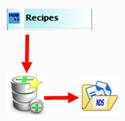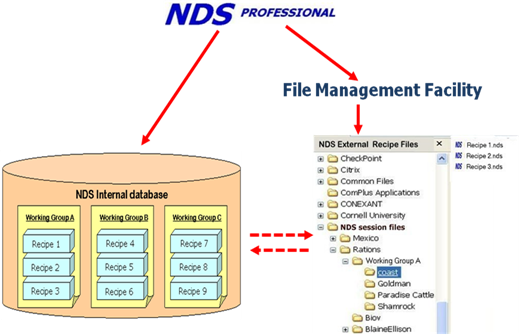
The goal of NDS data management is to reduce repetitive
inputs, making the process easy and safe. It is designed to handle the saving of the
recipes in a double mode:
•Into a main database (Access or SQL), where data are stored internally and immediately available without having to select a file. The list management developed allows, in fact, the search and selection of the relevant data in a quick and intuitive way;
•Into a single database, also called recipe file or external file, that should be selected in a folder defined by the user.
Also called Internal/External data management, it has the distinguishing feature that while saving on the main database, the recipes will be automatically saved in external files by a File Management Facility.

Both kinds of data management appear to have pros and cons:
|
Main Database
Pro - Data are saved in a unique DB and therefore you do not need to extract them from different connections (e.g. lists) with an advantage in terms of time and efficiency; - Editing operations on data sets are faster (e.g. transfers or changes) and repetitive inputs are reduced; - Data is guaranteed to be unique in a more secure way (e.g. variation analysis of a specific feed); - Analysis functions operating on large data sets (e.g. User Feed Lists, Feed Inventory management, Whole Farm Optimization) are easier and more efficient; - The user cannot compromise the integrity of the data by manipulating single files; their management is done exclusively through tools that operate at a higher level of abstraction; - The backup of the data are easily and automatically done, and the security copies are stored in a unique file.
Cons - Exchanging data between users requires intermediate files by export and import features; - The DB can become very large with consequent increased of some maintenance operations.
|
Single recipe file
Pro - Single recipe file has reduced size therefore processing times are shorter; - Exchanging data among users is done easily with the transfer of a single recipe file.
Cons - All operations involving data from different files are less efficient, since it is necessary to open a connection for each file; - Users have to organize their data in a folder structure at operating system level; - Data manipulation system implies additional handling of files at OS level, resulting in degraded performance (deep allocation of folders where the files are saved); - Some data are duplicated in several files, resulting in redundancy and, in some cases, the need to keep them aligned (reconcile function); - Through the manipulation of individual file, the user can compromise data integrity; - The data backup need to handle a lot of single file saved in a folder structure.
|
The goal to combine into NDS the advantages of both systems, together with the need to share the recipes data has driven us to implement this dual data management system, providing the ability to create single recipe file containing all recipes data within a structured database framework.
